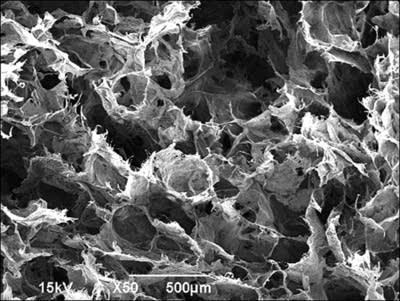Fargo researchers using nano technology to grow replacement bones

When doctors replace someone's hip or knee, they typically use a metal or ceramic artificial replacement.
But developing techniques may soon allow surgeons to implant replacement bones grown from the patient's bone marrow cells.
North Dakota State University scientist Kalpana Katti, who studies materials at the molecular level, hopes to solve a significant challenge of bone engineering by creating a three-dimensional mesh for bone cells to grown on.
"Your body cannot create new bone," said Katti, a distinguished professor of civil engineering. "But what if we could teach the body to make a new bone? That's the holy grail."
Create a More Connected Minnesota
MPR News is your trusted resource for the news you need. With your support, MPR News brings accessible, courageous journalism and authentic conversation to everyone - free of paywalls and barriers. Your gift makes a difference.

Such research is important, given the more than 750,000 hip and knee replacements every year in the United States. That number is expected to grow with an aging population.
Though Katti faces many challenges, her research could lead to significant advancements in such surgery. A key ingredient will be molecular, or nano-sized, clays. A thousand nano-clay particles stacked up would be as thick as a single sheet of paper.
Katti, who first became intrigued by bone tissue engineering in 1997, began using Red River Valley clay a few years ago in her research. To make the three-dimensional mesh structure for bone growth, she combines nano-sized clay particles with a polymer, or string of molecules made out of pectin from fruit, and chitosan from shrimp shells.
The result is a very strong porous material that supports healthy bone cell growth, Katti said. That mesh-like structure is then seeded with bone cells and nutrients.
"We have seen the initial stages of bone formation already happening," she said. "We've seen the structure and chemistry of this new engineered bone structure is exactly like real bone."

The bone growth so far is very small, less than a millimeter long.
Katti said a new piece of equipment being built at NDSU will provide a sterile, nutrient-rich environment where she will attempt to grow a fully formed bone over the next few months.
Hip or knee replacement involves surgically attaching a metal or ceramic device to the bone. Those bone replacement materials wear out after a few years. They also can cause surrounding bone to deteriorate.
Katti said replacement bone grown from a patient's bone marrow cells would be a longer-lasting, more compatible solution.
In the last decade, Katti has received more than $2.2 million in grants from the National Science Foundation.

She said research dollars will be the deciding factor in how quickly replacement bones become a medical option.
"This is the next big thing," she said. "If significant money goes into this we will have bone tissue engineered in 10 years."
Katti said the research effort's focus on bone growth at the molecular level could also lead to new treatments for diseases like osteoporosis and arthritis.
